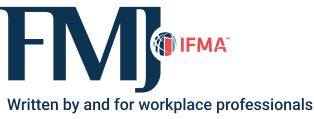Turning the Tide
Navigating the great retirement

In any organization, employees are the most important assets. This is certainly true in facility management. Much of the information about the location, history and condition of buildings is known only to experienced FM professionals and not written down anywhere. This is particularly challenging when critical infrastructure assets are often hidden above ceilings, on roofs or underground.
This fact becomes a liability as those experienced team members look to retire. As reported in the January/February 2019 issue of IFMA’s FMJ, nearly half of the FM workforce is expected to reach retirement in the next few years. That presents a unique challenge to FMs. How do they capture institutional knowledge about these critical infrastructure assets? Ensure key data points are accessible to the team beyond a colleague’s retirement? Facilitate a successful transition plan to the next group of people tasked with managing facilities?
The challenge ahead
In today's economy, the baby boomer generation (those born between 1946 and 1964) make up 25 percent of the workforce. In facility management, the ratio is higher. In an IFMA survey on this topic, 45 percent of respondents were baby boomers. While this generation has tended to be very loyal -- staying in a position for many years or decades -- they are collectively approaching retirement age. When these individuals choose to retire, they invariably leave large shoes to fill as the skills, knowledge and experience they have built up over many years in service are difficult to replace. This is especially true in today's very tight labor market.
As an added challenge to FMs, incoming generations in the workforce have different expectations than their predecessors. The Computing Technology Industry Association found that most millennials (those born between 1981 and 1996) consider using technology when evaluating current or future employers — and that over half of them are using online or cloud-based tools for common workflows. Meanwhile, Dell Technologies found that 80 percent of Gen Z (those born between 1997 and 2012) workers aspire to work with innovative technology. This presents an important opportunity for FM executives.
The knowledge at stake
It may be helpful for teams to take a step back and explore what information is at risk as this large cohort of FM professionals nears retirement. Taking an inventory of what data needs to be documented can help an organization develop a game plan to capture the information necessary to navigate a smooth transition.
If a company’s entire FM team retired tomorrow, it would be beneficial to have a central repository of information that includes the following:
-
Location data. Thinking beyond the location of the facilities themselves, teams should put in the effort to document the location of individual assets within those facilities. Where are the critical valves and switches? Which assets are located underground or above ceilings? Where are the wastewater cleanouts, sumps, drains and oil traps? What other hidden infrastructure components need to be noted?
-
Asset relationships. There are systems of systems inside each facility, from lighting and plumbing to HVAC and electrical. The relationships and connectivity across these systems are valuable information to share with anyone managing a facility. Which valves need to be shut to isolate a specific leak? Which HVAC components impact the first floor, and which affect the third floor? Which circuits are serviced by each electrical panel?
-
Project history. Blueprints are typically accurate when a building is first built. However, when that first renovation happens, it is common for documentation to fall out of date. If a team was not part of the construction or renovation project, vital information could be lost in translation. Which systems were updated when the building was remodeled in 2002? Where is all the permit documentation stored? What building systems were impacted by each renovation project? What is the asbestos (or other problematic material) remediation history for this building?
-
Facility conditions. To fully understand the health of their buildings and guide future spending decisions, organizations need access to up-to-date condition information. This includes evaluating the major systems in a facility, determining their remaining useful life, and planning for repair or replacement activities. What condition are the windows in? When is the HVAC system due to be replaced? What is the remaining useful life of the roof? Which roofs have experience historic moisture, ponding, or other problems? What areas are historically vulnerable to flooding?
The value of a detailed map
Once an organization has identified which datasets need to be documented in the face of the Great Retirement, the fun begins. Capturing data in an accurate and useful way can be a daunting task. There are several best practices a team can deploy to capture institutional knowledge and clearly organize it in a way that is practical and helpful for future team members in any generation.
-
Create a location-based asset inventory. Many organizations have at least started the process of creating an asset inventory in GIS. In these cases, teams can work from existing GIS databases: assessing accuracy and filling in the gaps where needed. It is smart to involve experienced team members in populating an asset inventory. These professionals have first-hand knowledge of the subject matter. They know what assets are on which floor and how systems are connected. FM technology has advanced significantly in recent years, and tools are available that are both powerful and user-friendly. When capturing facility operations data, organizations should look for location-centric solutions that allow the user to locate the assets in the context of a floor plan.
-
Define a clear database hierarchy. A unique challenge of managing facilities is the vertical nature of the assets. With a location-based hierarchy (site > building > floor > space), an organization can clearly index project files, assessments and inspections. A straightforward database structure is particularly important when managing multiple campuses with multi-purpose facilities. To help future team members quickly access the information they are looking for, FM professionals must take the time to establish a logical hierarchy of data. Some organizations do this by creating standard naming conventions that include the building’s address, along with details about floors, rooms and other relevant data points.
-
Conduct an interview process. The best-laid plans are just that: plans. FMs know that things come up and circumstances change. If an organization has the benefit of long-time FM professionals, they benefit from a lot of institutional knowledge about the risk factors in their facilities. Leaders should conduct a detailed interview process with these team members. This interview should include questions about aging infrastructure, the presence of hazardous materials, the location of historic leaks and other details that may be helpful to pass along. It is important to document this information and the locations of these risks as closely as possible.
Leveraging technology to bridge the gap
As organizations prepare for experienced team members and their institutional knowledge to retire, it may be time to invest in more and better technology. FMs can use investments in upgraded technology to simultaneously accomplish several goals.
-
Update the facility inventory. Management decisions require current and accurate data. Experienced workers may not have had the time or the inclination to keep facility asset data current. Now would be a great time to address this data gap. By pairing a more experienced worker with a new hire to conduct an asset inventory and facility condition assessment using modern technology, an organization can achieve many objectives in one set of activities:
-
Improved asset data. As each asset is located and inspected, the data becomes more complete and more accurate.
-
Hands-on learning. New hires will get a hands-on understanding of the location of all the hard-to-find assets that are above ceiling panels, in basements, on roofs or in the landscape. This is important in building their familiarity with the facilities they will be responsible for operating.
-
Knowledge transfer. The knowledge from more experienced workers will be captured digitally, which will make it easier to curate and reference going forward.
-
Relationship building. Older and younger employees will have the opportunity to build mentoring relationships that help the older employees feel respected and appreciated and help the younger employees find the guidance they desire.
-
Build preventive maintenance plans. Improving the balance of proactive to reactive maintenance is an objective of any facility management organization. For example, the maintenance cadence of older equipment may only be known to more experienced employees. Pairing an experienced employee with a new hire to document the preventive maintenance plan will help capture that knowledge and build up the new hire’s skills as they learn the finer points of maintaining older equipment.
-
Capture existing data into an enterprise system. Old-school data management often involved volumes of files stored in complex folder structures on the file system. Many organizations have huge amounts of valuable data squirreled away on a shared drive, with the location known only to those who filed it away in the first place. Ensuring these files are associated properly within a facilities information system will ensure that their value is not lost.
More broadly speaking, technology will help build an organization’s capacity to be more resilient and sustainable over the long term. In a recent lesson learned, organizations that had good facility data and systems in place were able to quickly evaluate management alternatives related to COVID-19 response. This will continue to be the case in the future as new management challenges arise.
For some local government and education organizations, there is funding available through the federal infrastructure bill that is directly supportive of technology investments to monitor the performance of organizational improvements.
Keys to success
-
Lead with empathy. The best FM leaders lead with empathy when undergoing organizational change. They take the time to collectively recognize that things are changing and remind their team members to have patience with the process. By encouraging the group to find common ground, they enable smoother transitions and positive outcomes.
-
Balance strengths. In times of transition, facility managers have an opportunity to take a step back and identify various strengths across the team. Perhaps the experienced managers see the value of technology, but struggle to incorporate new tools into workflows they are accustomed to. Meanwhile, newer team members may be quick to pick up a software tool but lack the experience or deep knowledge to understand key nuances of the use case. Pairing these groups together to navigate transitions and solve problems can drive surprisingly effective outcomes.
-
Set clear goals. Leaders must be clear about the destination to keep an organization moving in the same direction. Many groups find success by starting small, then building bigger. A team can use small wins to drive momentum by breaking a larger goal into smaller achievable steps. As with any major change, leaders should keep the team focused on mutual pain points and a shared desired outcome.
Technology is not a silver-bullet solution to any management challenge and the impending Great Retirement is no exception. However, suppose FMs can be thoughtful with technology investments and combine those investments with best practices to document and organize critical information. In that case, they may be able to navigate this transition smoothly and emerge as stronger stewards of these valuable facilities.

Stu Rich is an industry lead at Cartegraph where he leverages nearly two decades of experience to help facility management professionals build higher-performing building and infrastructure operations. Previously, Rich served as the CTO of PenBay Solutions. There, he led the team that published the first Buildings Interior Spatial Data Model (BISDM) as an open-source data model project for organizations interested in modeling their buildings in GIS.
Read more on Leadership & Strategy or related topics Workforce Development , Staffing and Succession Planning
Explore All FMJ Topics









